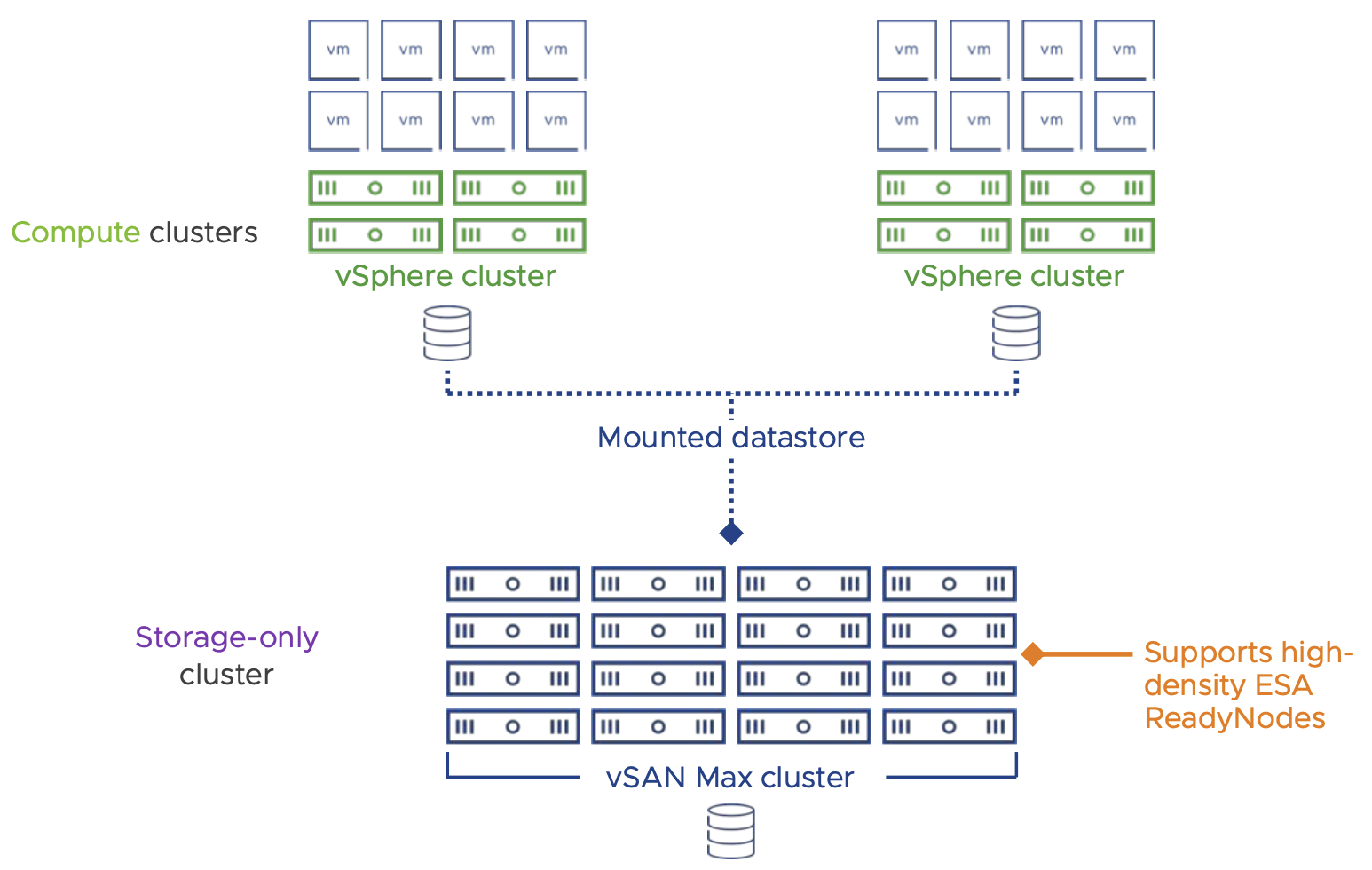At VMware Explore US 2023 in Las Vegas, VMware announces vSAN 8 U2 with the new vSAN Max™ architecture!.
At the time of writing, no set General Availability date has been published, but look for it being available some time this fall. Some details may also change before the product hits the market.
vSAN Max#
The clear stand-out new offering in vSAN 8 U2 is the new Disaggregated Storage offering called vSAN Max™. Broken down to its core, this is vSAN HCI Mesh on steroids, with some new and very shiny sprinkles on top. vSAN Max™, with its new license model, is a dedicated storage cluster, built on vSAN ESA. A vSAN Max™ cluster only provides storage resources, and does not run traditional VM workloads.
This storage cluster can be consumed by other vSphere clusters, either as a primary storage option or in addition to the storage those cluster already consume from other sources.

This allows for the disagregation between compute and storage resources, while at the same time offering the benefits of integrated management.
vSAN Max™ also supports stretched clusters, for a true enterprise multi-site setup. A single host in can offer up 360 TB of pure NVMe storage, allowing vSAN Max™ to scale into the petabyte territory.
vSAN Max™ client clusters can be traditional vSphere clusters or vSAN ESA clusters. These clusters can be managed by same or different vCenter Server than vSAN Max clusters. Storage traffic goes over the vSAN networking stack.
Planned Consumption and Deployment Model#
vSAN Max™ will be a new offering in the vSAN family
- Existing vSAN editions will not include vSAN Max™
- Licenses contain all necessary entitlements
- For any vSphere cluster or Cloud Edition
Planned with a new per-TiB licensing model
- Existing vSAN editions will still have a per-core licensing model
- Minimum per-TiB required to purchase
- Requires new ESA-based vSAN Max certified ReadyNodes
- Requires min. of 6 nodes, 150 TiB/node (minimum total vSAN size equals 900 TiB)
- No support for in-place upgrades from other vSAN editions
My Thoughts#
This is an interesting move by VMware. Offering a “pure storage solution” is new, but it makes sense as one of the inherent problems with HCI in general is scaling storage independently to the compute. This takes care of that, and at the same time it allows for smaller vSphere clusters to get the performance benefits of larger ones.
In environments where smaller clusters are beneficial, like database clusters (for licensing purposes), you’d normally take a performance hit, or go with external dedicated storage. This allows for the best of both worlds, while still allowing you to stay within the licensing boundries, as vSAN Max doesn’t allow you to run VMs on those clusters. That eliminates a pain point in many licensing discussions. Of course, this also depends on how VMware is going to price the licensing for vSAN Max™, which is unknown at this time.
At the same time, this proves that VMware really believes in vSAN ESA. It has only been a year since vSAN ESA was announced yet this new edition shows that it can do what VMware anticipated it could, and now want to go head to head competing with external storage vendors.
I also wonder if this means we’ll see vSAN Max™ clusters running on non-x86 architectures in the future. Why not run it on ARM CPU’s, and utilize the hight core count for even faster deduplication, compression and encryption? Since vSAN Max™ is licensed on capacity and not sockets/cores, it could quite possible be on a future roadmap.
Where does things like DPU’s fit in this picture, can those be utilized to offload processing in the future? I am sure there is more to come here as well, seeing that vSAN ESA seems to allow a more rapid pace of development.
